Treasure hunting in Sea of Thieves offers thrilling adventures and rewards, but success relies on effective crew dynamics and strategic gameplay. This article explores different voyage types, such as Gold Hoarders and Order of Souls, and emphasizes the importance of teamwork and communication. Additionally, it provides tips for efficient treasure hunting and highlights unique treasures and player interactions that enhance the overall experience.
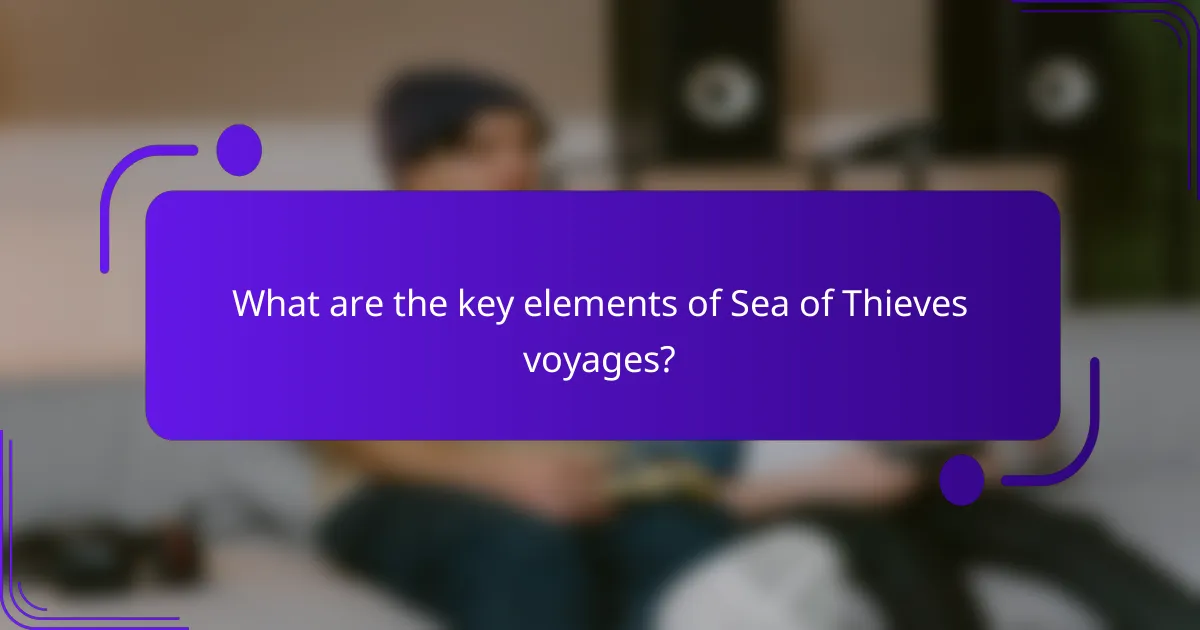
What are the key elements of Sea of Thieves voyages?
Sea of Thieves voyages consist of quests that involve treasure hunting, crew cooperation, and strategic gameplay. Players embark on missions to locate buried treasure, complete challenges, and engage with other players.
Key elements include the type of voyages, such as Gold Hoarders, Order of Souls, and Merchant Alliance, each offering unique rewards. Crew dynamics play a crucial role, as effective communication and teamwork enhance the experience. Tips for success include understanding map reading, managing resources, and utilizing ship capabilities.
These voyages are designed to foster exploration and adventure, making them central to the Sea of Thieves experience.
How do treasure maps function in the game?
Treasure maps in Sea of Thieves guide players to hidden loot by revealing locations on islands. Players use these maps to navigate and coordinate with their crew, enhancing teamwork and excitement. Each map varies in detail and complexity, with some indicating specific landmarks while others require exploration. Successful treasure hunting relies on deciphering map clues and overcoming environmental challenges.
What types of quests are available for players?
Players can engage in several types of quests in Sea of Thieves, primarily focused on treasure hunting and crew dynamics. The main quest types include Gold Hoarders, which involve finding buried treasure; Order of Souls, centered around defeating skeletons and retrieving their skulls; and Merchant Alliance, which requires players to deliver goods. Each quest type offers unique challenges and rewards, enhancing the gameplay experience. Additionally, players can participate in time-limited events and community challenges for extra rewards.
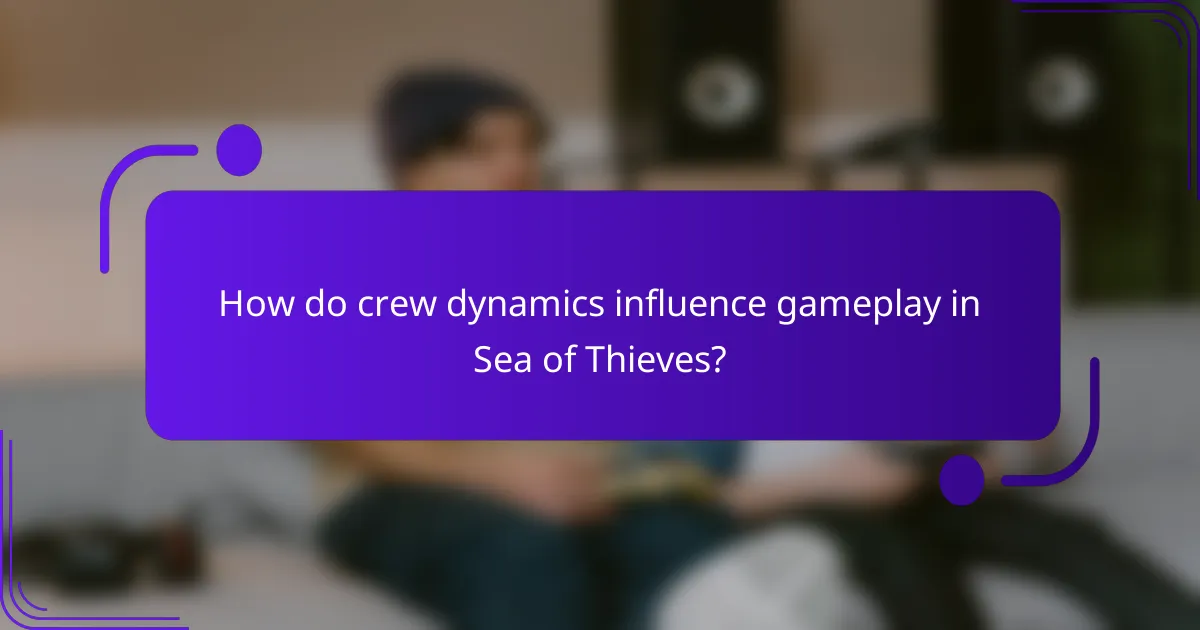
How do crew dynamics influence gameplay in Sea of Thieves?
Crew dynamics significantly influence gameplay in Sea of Thieves by enhancing collaboration and strategy. Effective communication fosters teamwork, allowing crews to navigate challenges and maximize treasure hunting success. The roles players assume, such as captain or navigator, impact decision-making and mission execution. A cohesive crew can adapt to threats, making them more resilient against rival players and environmental hazards. Conversely, poor dynamics can lead to disorganization, reducing efficiency and increasing vulnerability.
What roles can players take on within a crew?
Players can take on various roles within a crew in Sea of Thieves, including captain, navigator, gunner, and treasure hunter. Each role contributes uniquely to the crew’s success during voyages.
The captain leads the crew, making strategic decisions and guiding the ship. The navigator charts the course, ensuring safe passage through treacherous waters. Gunners operate the ship’s cannons, defending against enemy attacks. Treasure hunters focus on locating and retrieving loot, maximizing rewards for the crew.
Effective crew dynamics depend on communication and collaboration among these roles. Players can switch roles based on the crew’s needs, enhancing adaptability during gameplay.
How does communication affect crew success?
Effective communication directly enhances crew success in Sea of Thieves by fostering collaboration and minimizing misunderstandings. Clear dialogue enables crews to coordinate treasure hunting efforts, share strategies, and respond swiftly to threats. When crew members articulate their intentions, it builds trust and improves morale, leading to a more efficient and enjoyable gameplay experience. Furthermore, regular communication helps in managing resources, such as supplies and ship repairs, ensuring that the crew remains prepared for challenges. Overall, strong communication is a key factor in achieving successful voyages and maximizing treasure gains.
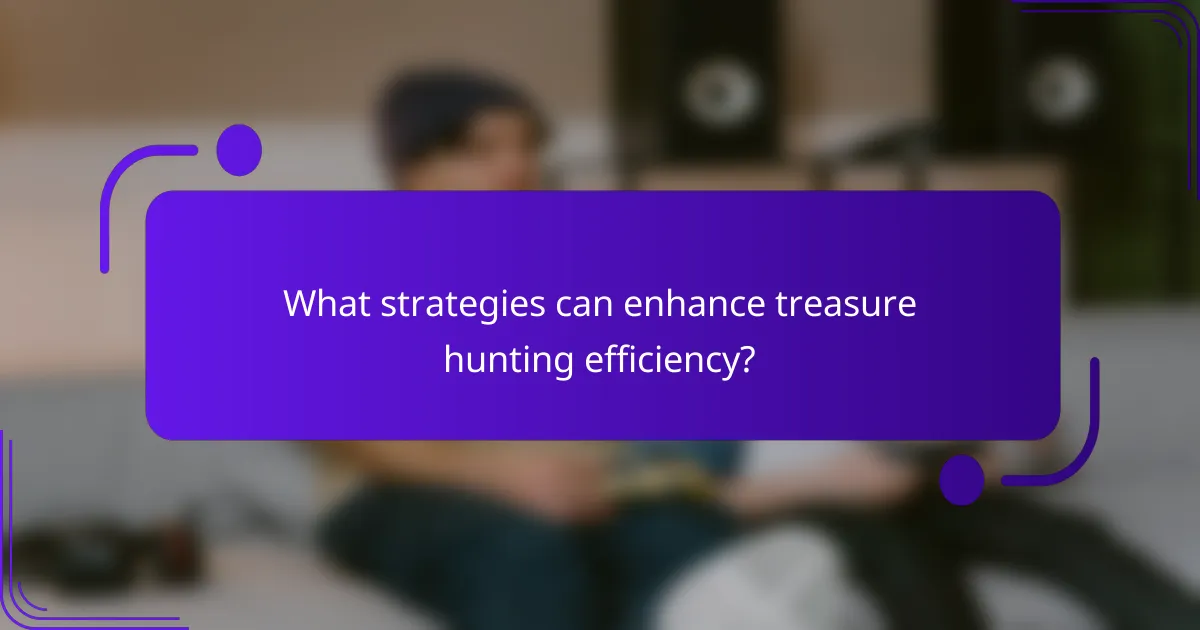
What strategies can enhance treasure hunting efficiency?
To enhance treasure hunting efficiency in Sea of Thieves, focus on teamwork, communication, and strategic planning.
Effective crew dynamics improve navigation and resource sharing. Assign roles based on strengths, such as navigator, lookout, and treasure hunter. Utilize in-game tools like maps and compasses to streamline your search.
Prioritize communication to share discoveries and coordinate actions. Regularly check in with crew members to align on objectives and adapt strategies as needed.
Implement a systematic approach to treasure locations. Identify high-yield areas and prioritize them based on past experiences and treasure types. This reduces time spent searching and increases treasure collection efficiency.
Which tools and equipment are essential for successful voyages?
Essential tools for successful voyages in Sea of Thieves include a sturdy ship, navigational instruments, and combat equipment. A well-equipped crew enhances treasure hunting efficiency. Key items include the compass for navigation, cannons for defense, and a map for locating treasure. Each tool contributes to a successful journey, ensuring safety and effectiveness during adventures on the high seas.
How can players effectively manage inventory during quests?
Players can effectively manage inventory during quests by prioritizing essential items and regularly communicating with crew members. Organizing supplies based on their use, such as food, ammunition, and treasure, helps streamline operations.
Keeping a balanced inventory prevents overloading and allows for quick access to necessary resources. Players should also utilize ship storage efficiently, ensuring that valuable items are secured while less critical supplies are easily accessible.
Regularly assessing inventory during voyages ensures that players can adapt to changing situations and remain prepared for encounters. Establishing a system for sharing resources among crew members enhances overall efficiency and teamwork.

What are the unique treasures players can discover?
Players can discover unique treasures in Sea of Thieves, including legendary chests, rare artifacts, and special event rewards. Legendary chests, such as the Chest of Legends, grant high-value rewards. Rare artifacts include the Ashen Keys and the Cursed Captain’s Chest, which offer unique benefits. Event rewards, like the seasonal treasures, are limited-time collectibles that enhance gameplay. These treasures not only provide valuable loot but also enrich the adventure experience.
How do rare items impact gameplay and player experience?
Rare items significantly enhance gameplay and player experience in Sea of Thieves by offering unique rewards and fostering teamwork. These items can provide substantial advantages, such as increased treasure value or exclusive cosmetic upgrades. Players often feel a sense of accomplishment when discovering rare items, which can boost engagement and motivation. Furthermore, the pursuit of these items can improve crew dynamics, as players collaborate to strategize and achieve shared goals. The thrill of finding rare treasures adds excitement and depth to the overall gaming experience.
What are the most sought-after treasures in 2025?
In 2025, the most sought-after treasures in Sea of Thieves include ancient relics, cursed artifacts, and legendary chests. Players pursue these treasures for their unique attributes and high-value rewards. Ancient relics often provide lore insights, while cursed artifacts impose challenges that enhance the gameplay experience. Legendary chests, known for their rarity, yield substantial gold and exclusive cosmetic items. Mastering crew dynamics and employing effective treasure-hunting strategies significantly increases the chances of success in locating these coveted items.
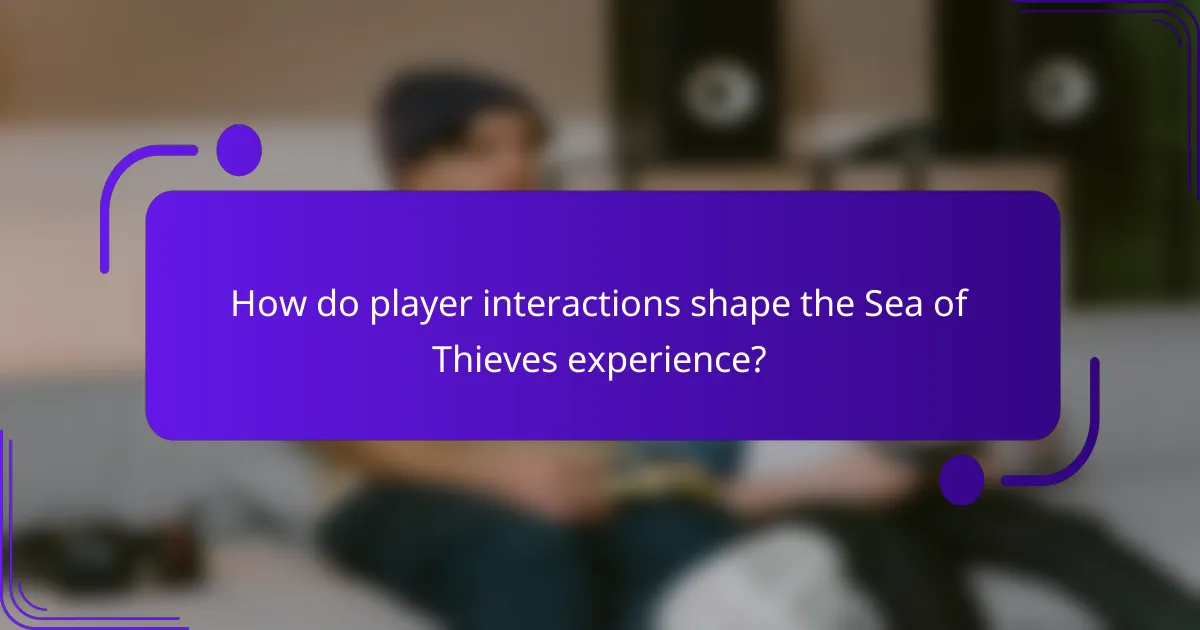
How do player interactions shape the Sea of Thieves experience?
Player interactions significantly enhance the Sea of Thieves experience through collaboration, competition, and shared stories. Engaging with other players fosters teamwork, which is crucial for successfully completing voyages. Players can form alliances, share resources, and strategize together, making the treasure hunting process more dynamic.
Competitive encounters with rival crews add excitement and unpredictability to the game. These interactions create memorable moments, such as epic ship battles or clever ambushes, which enrich the overall gameplay experience. Additionally, the game’s open-world design encourages players to explore and discover unique interactions, leading to rare encounters and unexpected alliances.
Effective communication among crew members is essential for smooth operations. Utilizing voice chat or in-game signals can improve coordination during quests. Sharing tips and experiences with fellow players can also enhance skills and strategies, making each voyage more rewarding.
Ultimately, player interactions shape the Sea of Thieves by creating a vibrant community where every adventure is influenced by the actions and decisions of others. This interconnectedness is a unique attribute that defines the game and keeps players engaged.
What are the benefits of alliances between crews?
Alliances between crews in Sea of Thieves enhance treasure hunting efficiency and increase survival chances. Collaborating with other crews allows for shared resources, strategic advantages, and combined firepower against threats. This synergy often results in greater treasure yields and a more enjoyable gameplay experience. Moreover, alliances can lead to unique encounters and storytelling opportunities, enriching the overall adventure.
How can betrayal affect gameplay dynamics?
Betrayal can significantly disrupt gameplay dynamics in Sea of Thieves by altering crew trust and cooperation. When a player betrays their crew, it can lead to immediate conflict and distrust, affecting team strategies and decision-making. This betrayal can manifest in various ways, such as stealing treasure or sabotaging missions, which can diminish the overall enjoyment of the game for the affected players. As a result, the group may struggle to work together effectively, impacting their chances of success in treasure hunting and other voyages. The psychological impact of betrayal can also lead to a cautious atmosphere, where players become suspicious of each other’s intentions, ultimately changing the social fabric of the crew.
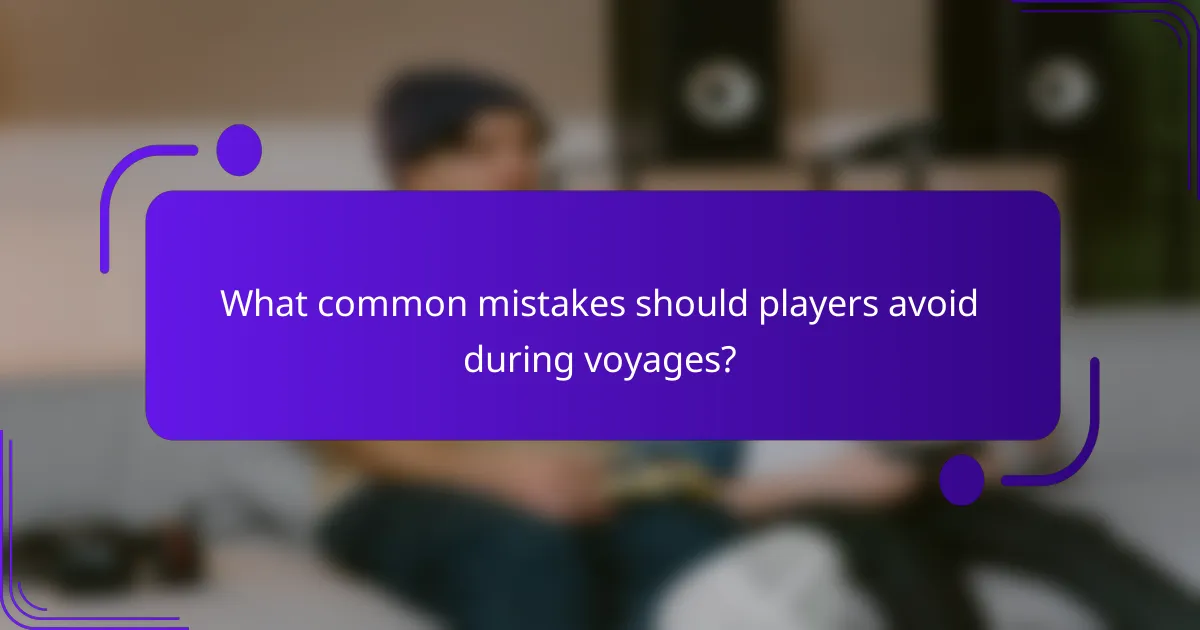
What common mistakes should players avoid during voyages?
Players should avoid common mistakes like poor communication, neglecting ship maintenance, and not planning routes. Effective teamwork is crucial for success in Sea of Thieves. Failing to share treasure maps can lead to disorganization. Ignoring the ship’s condition can result in unexpected battles. Additionally, players should avoid rushing into encounters without assessing the situation, as this can lead to unnecessary losses. Prioritizing strategy over impulse enhances the overall voyage experience.
How can players prepare for unexpected encounters?
Players can prepare for unexpected encounters by enhancing their situational awareness and communication. Equip your ship with essential supplies, including cannonballs and food. Establish clear roles within the crew to react quickly during surprise attacks. Practice teamwork through drills, ensuring everyone knows their responsibilities. Familiarize yourself with the map to anticipate potential threats from other players or environmental hazards. Engaging in regular skirmishes can also improve your readiness for real encounters.
What are the best practices for successful treasure hunting?
Successful treasure hunting in Sea of Thieves requires teamwork, strategy, and resource management. Effective communication among crew members enhances coordination. Utilize maps and clues to locate treasure while keeping an eye out for rival crews. Prioritize gathering supplies, such as cannonballs and food, to ensure readiness for encounters. Adapt to changing circumstances and remain vigilant for environmental hazards.